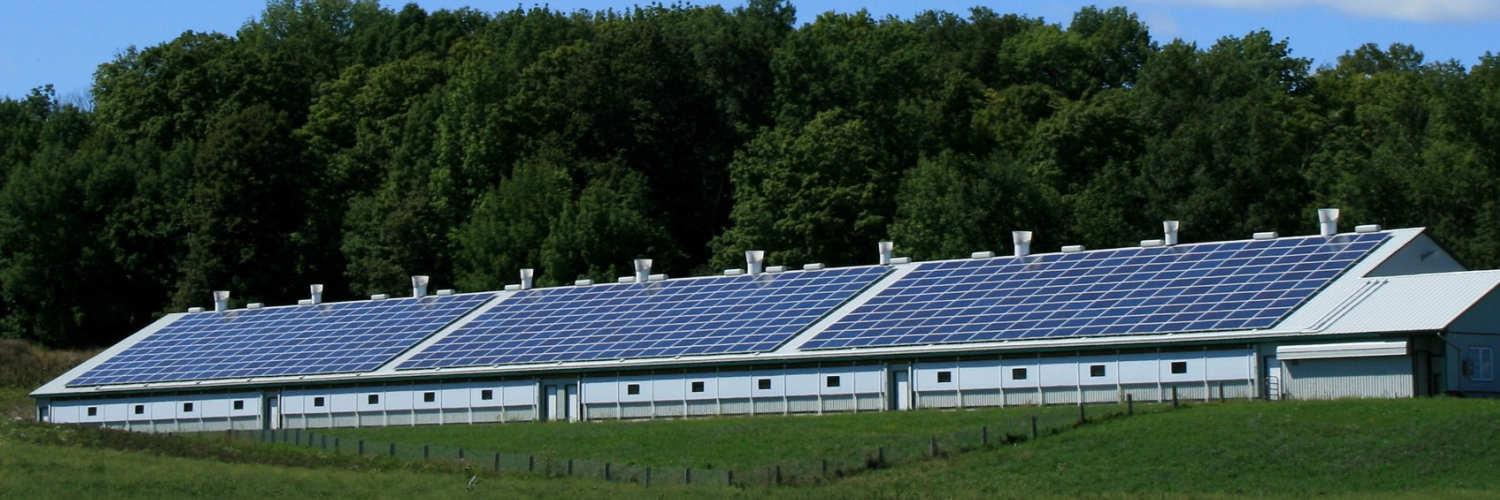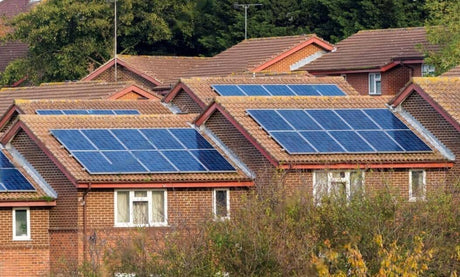Late 2022 has seen sharply rising energy prices all over the U.K. Regulators have allowed electricity prices to rocket out of control as the Q1 2023 price cap is projected to reach £4,200. Remember, the price cap only refers to an average price per unit, not the maximum each home will pay.
With prices in England set to top 50p per kWh, a cost of living crisis is brewing. At these prices, which are not projected to fall any time soon, the break-even point for large solar panel installations is now under 5 years.
How is that possible? Read on!
How does an off grid solar panel system pay back in 5 years?
Here's an example taken from an early September calculation:
- Electricity Price: 50p per kWh.
- Solar Panel Generator Capacity: 12 kW
- Roof Orientation: SE facing, 20-degree tilt, no shade
- Percentage Sold Back To Grid: 0%
- Yearly Energy Savings: £4,200
- Estimated System Cost - No Battery: £16,500
- Estimated System Cost - With House Battery: £26,500
- Break Even Point - No Battery: 4 Years
- Break Even Point - House Battery: 6.3 Years
A 12 KW installation was chosen so that yearly energy savings match the new estimated price cap as closely as possible. If you can use it, a 20kw system is even more efficient. Assuming you don't sell any back, it will save you around £7,200 annually.
But these big systems are only realistic out in the country. Most houses near the city won't go above a 4KW to 6KW installation; they simply don't have the roof space.
The good news? Most smaller, urban installations without the battery still have break-even points of under 5 years at current energy prices. And breakeven is reached at between 7 and 8 years with the battery.

Needless to say, if energy prices remain anywhere near their current levels, everyone in the U.K. who can afford it should be looking into solar power systems. It will undoubtedly reduce the cost of daily living, increase property values, and make rentals far more attractive.
Learn "how does an off grid solar system work" before going off grid
But what if you want to go one step further? The next step would be to figure out how off grid solar systems work.
Although many people will immediately think of solar panels when they hear the word "off-grid solar energy," the fact is that many other components must be included to form a fully functional off-grid solar power system.
A complete off-grid solar system is equipped with all the basic equipment to generate, store and supply electricity, such as solar panels, inverter, charge controller, and solar battery. The system can operate independently from grid electricity, but it does require rather a sizable amount of battery storage, which makes it more expensive than on-grid solar systems.
But what does it take to achieve a fully off grid solar system in the U.K. that meets the demands of the average home? And how long would it take to break even on such an ambitious project?
In order to answer these questions, we need to take a deep dive into the costs involved, the best technology that's available in late 2022, and any lifestyle impacts that the typical family needs to be aware of. More
So strap yourself in. We're going off the grid!
The real cost of off-grid living in the U.K.
So to determine how much solar you need, let's calculate the worst-case scenario. Sun-minimum months in the U.K. are November through February, when you can expect between two and three peak hours of solar generation a day. That means you need to be able to generate a full day's solar power in two hours, unless you want some fairly drastic lifestyle changes.
But what if you get a stretch of two to three mostly rainy days (which in the U.K. isn't exactly rare)? You'll be leaning pretty hard on your house battery, and likely won't get more than one hour of peak energy generation a day through the cloud cover.
With this in mind, you'll want at least a 15 KW off grid solar system to cover you during the winter and charge up your house's battery reliably during unfortunate weather patterns.
That's sixty 250W solar panels or seventy-five 200W solar panels - more roof space than most people have. The rule of thumb is 30 square meters of gently sloped south-facing roof space for every 4 KW of solar panels.
This is why the average off grid solar system in the U.K. either makes some compromises, or they are located in more rural areas where land is cheap and available. That way you can set up a few elevated systems in the yard, or leverage your bigger out-buildings… a well-designed barn has a heck of a lot of roof space.
That's the dream scenario, of course. There are ways to be more realistic if you don't have a big yard or outbuildings.

Let's say you're willing to go down to a 9 KW off grid solar system, and leverage an emergency generator for winter days that are near-sunless. You now need 40% less roof or yard space, and you can be a bit less lucky with stretches of bad weather and still survive.
A 5-kilowatt petrol generator will burn through 0.75 gallons of gas an hour. That should help you to calculate the gaps that you're likely to have over the four-month winter period in your particular part of the U.K. Northern Ireland and Scotland are going to need more 'plan B' winter help than average. If you end up using the generator for four hours every week, 20 weeks a year, you'll burn 60 gallons of gas at around £6.50 a gallon. So your stopgap measure will cost you around 400 quid a year. Not ideal, but there are always some additional costs when you have a fully off grid solar system.
Let's price up both scenarios and see where we stand. All costs are with some additional wiring and infrastructure in mind, given our off grid solar system's needs.
- Solar Panel Generator Capacity: 15 KW
- Roof Orientation: SE facing, 20-degree tilt, no shade
- Seventy-Five 200 W Solar Panels: £13,500
- House Battery: £10,500
- 5.5 KW Petrol Generator: £1,200
- Generator Inverter: £500
- Solar Inverter: £1,300
- Additional Infrastructure: £3,000
- Total Estimated Off Grid Solar System Cost: £30,000
- Normal Electricity Price Saved Per Year: £5,000 based on above average usage.
- Break Even Point: 6 Years
A six-year break even for an off grid solar system in the U.K. is unheard of. It represents historical electricity price increases, of course. But we see no signs of price drops in the near future, without serious government intervention.

Now let's look at the smaller array, and factor in generator fuel costs.
- Solar Panel Generator Capacity: 9 KW
- Roof Orientation: SE facing, 20 degree tilt, no shade
- Forty-Five 200 W Solar Panels: £8,100
- House Battery: £10,500
- 5.5 KW Petrol Generator: £1,200
- Five Years Petrol Use: £2,000
- Generator Inverter: £500
- Solar Inverter: £1,300
- Additional Infrastructure: £3,000
- Total Estimated Off Grid Solar System Cost: £26,600
- Normal Electricity Price Saved Per Year: £5,000 based on above-average usage.
- Break Even Point: 5.3 Years
The lower initial solar panel costs are somewhat blemished by the yearly gasoline bill for the generator. Still, it's a great break-even timeframe.
Changes to accommodate off grid living in the U.K.
There are a few simple changes that you can make in order to make the most of your off grid solar system. It requires a slightly different mindset so that you and your loved ones can form the right habits. But after a while, these things become second nature.
First of all, you need to develop a 'battery full' mode. When your house battery is full and the sun is shining, you're quite literally wasting any electricity that you don't use. Without a grid connection, you can't sell your excess energy back to anyone.
So plan your high energy usage activities for sunny days. If you know you're going to need to turn on the air conditioner in a couple of hours, consider pre-cooling the area while you're producing a bunch of excess electricity. If you need to use a vacuum cleaner or electric power tools, do it during peak sun hours whenever possible. A full house battery at high noon is a license to get stuff done!
You'll also need to develop an 'empty battery' mode. In those long winter months when energy is at a premium, avoid doing frivolous things without a safety net. Otherwise you'll be running that petrol generator way more often than you would like to.

Anytime you need to replace an appliance, go with the best-rated energy-saving model. You may pay a bit more, but you'll save money in the long run. This applies doubly to any appliance that runs constantly, like your refrigerator/freezer. New PCs should have higher efficiency power supplies, even if there's a thirty or forty quid premium. New power tools should be rechargeable whenever possible… bonus points if the batteries are interchangeable between various hand tools.
If you have an electric vehicle, it may have smarthome-friendly battery options. This will allow you to use your car as an extra battery in emergencies, using your existing DC converter. Remember to keep your car topped off whenever you have solar power to spare… it's always nice to have a 'plan C'.
Be prepared for emergencies. A 150W hand crank generator can literally save lives. You'll want one around when your house battery is completely drained and you really need to charge your phone.
Winter preparation, when solar energy is at its lowest, needs to be taken to a whole new level. Invest in extra blankets, fluffy house robes, and even long johns if that's your thing. Unpowered ways to keep warm are vitally important to avoid needing to use space heaters or electric blankets. Sure, you might have central oil or gas heating… but with fuel prices at their current levels, seeking other solutions is still a wise thing to do.
Is it worthwhile to buy an off grid solar system in the U.K.?
If we had a crystal ball and we knew that energy prices were going to remain ridiculous for the next few years, then the answer to this question would be a no-brainer.
But even without the gift of prognostication, we can make a general observation: Over the past decade, solar has gotten dramatically cheaper. Solar hardware prices haven't shifted too much since 2020, despite a recent global chip shortage and a pandemic.
Meanwhile, energy companies are price gouging during a major war and a medical crisis. They make record profits while people are dying in heat waves.
So yes, we think it's worthwhile. Even if it was only a break-even proposition, it would still be contributing to the health of our planet and the stability of the larger power grid.
But given recent energy pricing in the UK, and OFGEM's cowardly retreat in the face of big energy, the decision has become much easier for a lot of people. Even if you don't have the space to go fully off grid living uk, a smaller four to six KW solar panel installation can make a wonderful long-term dent in your utility bills.
Build your own off the grid solar system
Now is the best time to invest in your own off-grid solar. If you need a hassle-free shopping experience, look no further here. Renogy is a pioneer in off-grid solar products. At Renogy, we offer an all-in-one solution. We have all components that are needed for a complete off-grid solar system, such as inverters, charge controllers, solar batteries, and a wide selection of solar panels for sale.










